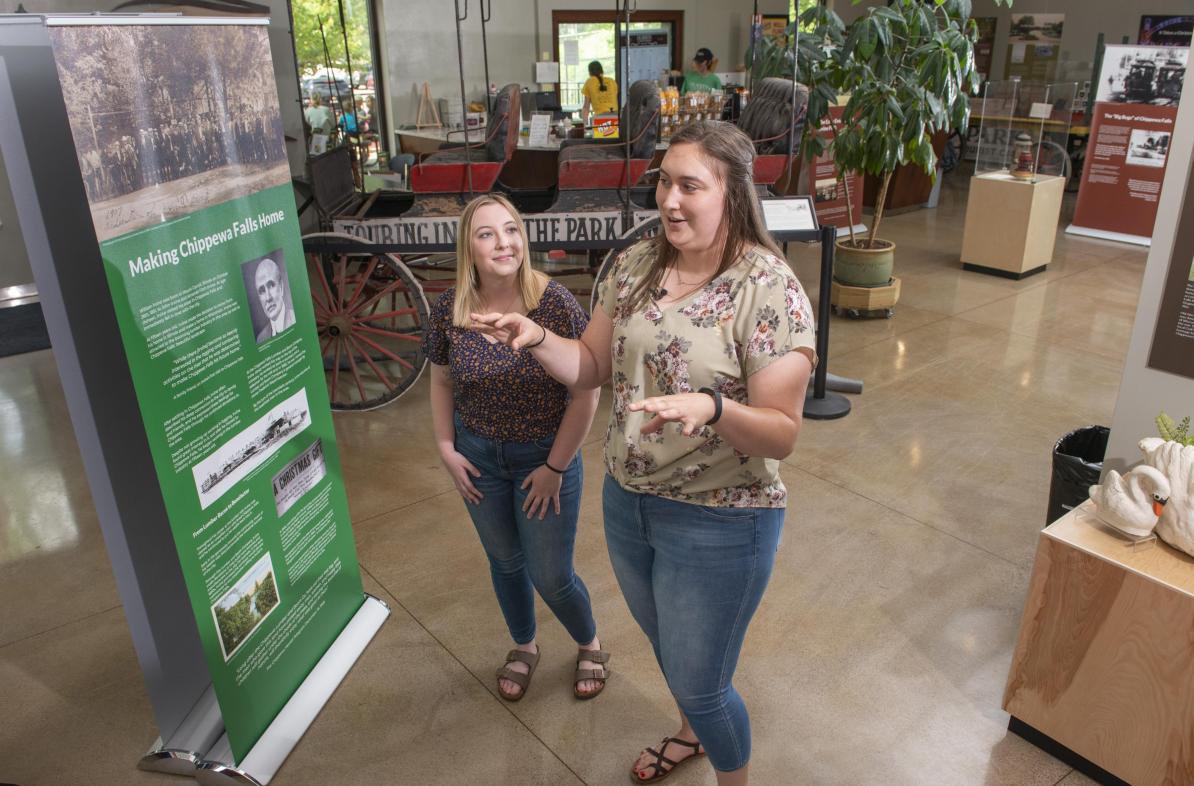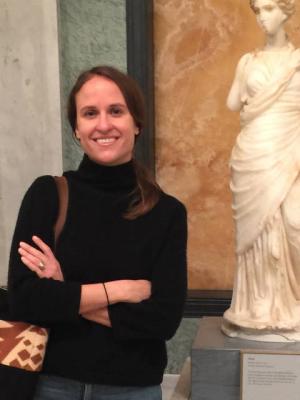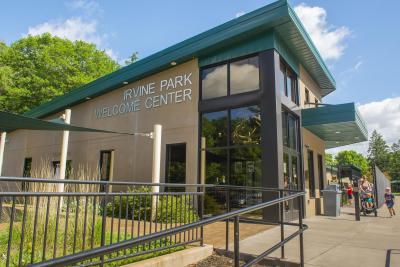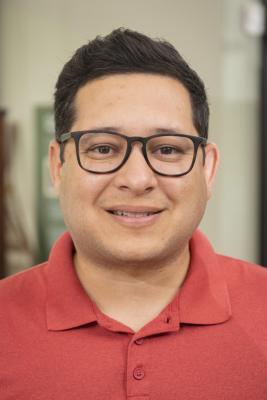
Public history students create exhibit in Irvine Park Welcome Center in Chippewa Falls
Visitors to Irvine Park in Chippewa Falls now can learn about the history of the city and park thanks to an exhibit in the park’s Welcome Center that was created by a public history class at the University of Wisconsin-Eau Claire.

“It’s a beautiful space and the plan always had been to have an exhibit there,” Dr. Cheryl Jiménez Frei, assistant professor of history at UW-Eau Claire, says of the Irvine Park Welcome Center. “However, the park lacked the resources and staff to get such a large exhibit project, which requires a lot of planning and specific skills, off the ground. So, that’s where we came in.”
Ten undergraduate and four graduate students in Jiménez Frei’s “Seminar in Public History” course completed the project during UW-Eau Claire’s spring semester.
The Blugold-created exhibit opened Memorial Day weekend to rave reviews by visitors and local officials, says John Jiménez, the director of Chippewa Falls parks, recreation and forestry.
“It’s extremely impressive,” Jiménez says of the students’ work. “I’m floored with how it all came out. I had an idea of what it would look like, but seeing it and walking through the history of Chippewa Falls, the park system and Irvine Park is simply amazing.”
The new exhibit fills a space that had mostly been empty since the Welcome Center was constructed in 2016. There were a few artifacts from the park's collections on display, but without interpretation.
Now, thanks to the students, park visitors can enjoy a well-researched exhibit that tells the story of Irvine Park from the Indigenous history of the land before the park's founding, to the present day. It highlights the park’s strong roots in the community and connects local history to a larger national story.
Graduate students in the class also created educational and interpretive materials for the "Learning Pod" in the Welcome Center, a place for young visitors and families to learn about the park’s history, ecosystem and the importance of conservation.
“We created a space for all ages to gather and to learn,” says Alexis Linder, a public history graduate student from Ellsworth who now is an intern at Irvine Park. “There is something here for kids and adults, and for people who have lived here all their lives and for visitors to the area.”
The timeline for the project was tight, but the students remained focused and optimistic, using their creativity, critical thinking and intellectual curiosity to bring local history to life, Jiménez Frei says.
“Their research revealed things about Irvine Park and Chippewa Falls that will enhance understanding of its significance for years to come,” Jiménez Frei says. “The fact that this exhibit will live on long after this class is something the students should all be very proud of.”
About the exhibit
The Welcome Center exhibit, “To Distribute the Enjoyment of our Natural Wealth: Civic Pride, Conservation, and Irvine Park in the National Story,” features five interpretive sections, each with a theme that tells the story of Chippewa Falls and Irvine Park’s place in local and national history.
The themes are The Land: Indigenous Origins; The Turn of the Century: Logging & Industry; The Movement: City Beautiful; The Zoo: Beginnings & Change Over Time; and The Community: Past, Present & Future.
At the core of any good exhibit is a “big idea” or a main message visitors should walk away with after viewing it, Jiménez Frei says. For the Irvine Park project, the big idea was centered on the fact that the park’s past and present reflect both local and national histories. The exhibit also focuses on the changing relationships between humans and the environment, and the importance of preservation.
The students say their exhibit celebrates the many “great” moments in the city and park’s history, but it also acknowledges the “darker” moments.
“We did not shy away from potentially controversial and provoking pieces, such as Indigenous lands, the minority experience in the area or animal welfare,” says Andrew Beine, a senior public history major from Eau Claire.

A challenging and rewarding project
Putting together an entire exhibit for such a large space in one 15-week semester was “very ambitious,” Jiménez Frei says, noting that it’s common for the planning and execution of an exhibit to take anywhere from one to three years, or longer, depending on the scale of the project. “I wanted to take on the challenge and I knew the students would be up for it as well,” she says.
Throughout the semester, the students learned and experienced the many steps it takes to create an exhibit, including research, interpretive planning, budgeting, funding proposals, working with multiple stakeholders, curation, design and installation.
“It was the classic definition of on-the-job training,” says Jordan Stish, a public history graduate student from Hibbing, Minnesota. “It was stressful, but seeing it completed made all the stress worth it. I would do it all over again if given the chance.”
In addition to a tight timeline, students also had a small budget. Exhibits similar in size to the Irvine Park project often cost more than a $100,000, but the Blugolds had an $8,000 budget, Stish says.
Students appreciated the funding from the Chippewa Falls Park Board and were ready to “DIY everything” to make it work, Linder says. Fortunately, community involvement was great, with everyone from the park’s zookeepers to friends to a local woodworker all stepping in to help by donating personal items or sharing their time and talents, Linder says, noting that her dad, a carpenter, built the display stands used throughout the exhibit.
In addition to the public history students, Blugolds from other academic disciplines also contributed to the project. For example, people associated with UW-Eau Claire’s education programs helped the history students understand how to best share information with younger children, Linder says.
Lexi Zellmer, who graduated in May with a degree in graphic design, worked with the public history students to design all the exhibit labels. She also designed new logos for Irvine Park and the Zoo.
“I cannot say enough about how great it was to have Lexi on the project, not only for the quality of her work, but also for the value of having public history students see the necessity of working across disciplines within this field,” Jiménez Frei says.
Incredible learning opportunity
The goal of the public history seminar course is to give students opportunities to work as public historians in practice — to take what they’ve learned and apply it to the real world, Jiménez Frei says.
It’s one thing to talk in the classroom about the diverse aspects of public historians’ work in different areas of the field and the challenges that may arise, but it’s a whole other thing for students to experience it, Jiménez Frei says. In this project, students worked on problem solving, critical thinking, research, sharing authority with multiple stakeholders, working with community partners and other key skills they’ll need in the future, no matter what area of the field they enter, she says.
“While it was ambitious to complete the exhibit in 15 weeks, I knew the students could do it,” Jiménez Frei says.
Beine appreciates that the project got him “into spaces that public historians will regularly be working in,” allowing him to experience every aspect of an exhibit from early inception and research to the actual implementation of display pieces.
Building an exhibit from the ground up also taught him the value of collaboration and teamwork, Beine says. Much of the students’ in-class time involved open discussions and brainstorming, he says.
“The project fit right into what I hope to do in my future,” Beine says. “I'm considering pursuing a graduate degree after my undergraduate studies, but museum work is where I ultimately want to land. This project involved a lot of what museum work entails, making it not only a great resume piece but also an experience to personally build upon.”
Stish also says the project will help her in her future career, especially since it offered her the rare opportunity to be part of a project from the “very beginning to the very end.” The experience solidified her plans to be an exhibit designer in a museum, she says.
“Getting to really be in the driver’s seat is not something students often get to do in such a comprehensive project,” Stish says. “It broadened my skills and my portfolio by giving me experience in everything from research to curation to community engagement and public relations.”
Linder agrees, saying being part of a large exhibit project that began with a “blank slate” will impress potential employers as she begins her career as a historian. She hopes to work for a museum in an administration role, building connections with stakeholders, visitors and others.
“When I go into a job interview and say there was nothing there and now here is this great exhibit we created, it’s going to be huge for me,” Linder says.

Looking ahead
Given what students accomplished in the Welcome Center, Jiménez already is looking for other opportunities to involve UW-Eau Claire students in parks projects in Chippewa Falls, saying a “continuing relationship with UW-Eau Claire will benefit us and the students.”
Future projects may include adding to the Welcome Center exhibit, which Jiménez describes as a “work in progress.”
“This is my first time collaborating with UW-Eau Claire and I have only positive things to say,” Jiménez says. “After we connected, I knew something special was going to happen but didn’t know how special. I’m excited about what’s here and about more collaborations in the future.
“Building these community bridges and having a resource like UW-Eau Claire in our backyard is a tremendous opportunity. It’s a partnership I hope will be here for a very long time.”
You may also like


